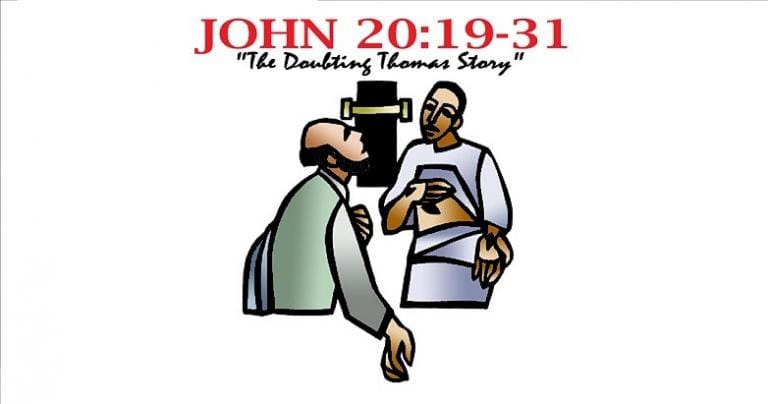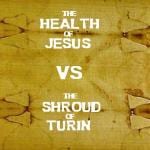
Thomas, the disciple associated with doubt and incredulity, is the featured character in the original ending of the Gospel called “John.”
Thomas and Divine Mercy go together every year. This Sunday’s Gospel is John 20:19-31 and it presents the Risen Jesus commissioning his disciples and the famous “doubting Thomas” episode. It is part of the original conclusion to the Fourth Gospel called “John” (John 20:1-31, as chapter 21 was a later appended section). In its original ending, “John” concludes by expressing that God vindicated Jesus, the Sent One, who truly ascended and then descended twice to his friends.
You can find the Gospel section below. I invite you to read it and then watch the video presentation linked above it. Next, go over (by yourself or with your family) the following questions—really ruminate and grapple with them. Later, in a follow-up post, I will go into more detail with this Gospel story.
John 20:19-31
On the evening of that first day of the week, when the doors were locked, where the disciples were, for fear of the Judaeans, Jesus came and stood in their midst and said to them, “Peace be with you.”
When he had said this, he showed them his hands and his side. The disciples rejoiced when they saw the Lord.
[Jesus] said to them again, “Peace be with you. As the Father has sent me, so I send you.” And when he had said this, he breathed on them and said to them, “Receive the holy Spirit. Whose sins you forgive are forgiven them, and whose sins you retain are retained.”
Thomas, called Didymus, one of the Twelve, was not with them when Jesus came. So the other disciples said to him, “We have seen the Lord.” But he said to them, “Unless I see the mark of the nails in his hands and put my finger into the nailmarks and put my hand into his side, I will not believe.”
(The Appearance with Thomas)
Now a week later his disciples were again inside and Thomas was with them.
Jesus came, although the doors were locked, and stood in their midst and said, “Peace be with you.”
Then he said to Thomas, “Put your finger here and see my hands, and bring your hand and put it into my side, and do not be unbelieving, but believe.”
Thomas answered and said to him, “My Lord and my God!”
Jesus said to him, “Have you come to believe because you have seen me? Blessed are those who have not seen and have believed.”
Now Jesus did many other signs in the presence of [his] disciples that are not written in this book. But these are written that you may [come to] believe that Jesus is the Messiah, the Son of God, and that through this belief you may have life in his name.
Questions & Directions for Reflection—
“Doubting” Thomas
It seems that the adjective “doubting” has forever marked our understanding of Judas Didymus Thomas, member of the Twelve. But the Fourth Gospel often presents us with typical characters, symbols who represent theological positions or traits that address pastoral problems experienced by the Johannine Jesus group. Examples of typical characters in “John” include the Samaritan Woman, the Sighted Blind Man, the Beloved Disciples Lazarus and Martha, and Mary Magdalene.
Consider that if the Johannine Thomas is a typical character symbolizing a condition that all early Jesus group members suffered, how should we understand him today?
Is the Thomas Story True or Factual?
Scholars are confident that the unknown, anonymous author we call “John” is not giving us a 21st century, fact-precise biography of Jesus and his earliest followers. Moreover, scholars believe that several stories in “John” are theological fictions addressing crises and pastoral issues in the Jesus group to which he belonged. Also, Catholics are not obliged to consider every detail and story in the Gospels as factual and historical.
What becomes of the truth of “Doubting Thomas” if this story proves to be yet another brilliant theological fiction invented by the author?
Thomas and the Skeptics
Often 21st century skeptics of the Bible caricaturize biblical peoples as a credulous, superstitious lot, gullible fools and suckers who will believe any fantastical account proposed to them. But the daily life of the Middle Eastern world of the Bible was very skeptical. This was because of its prevalence for secrecy, deception, and lying as legitimate and commonly used strategies to defend honor. Ancient and modern Middle Easterners are so skeptical they disagree with our Western maxim, “seeing is believing” as eyes are often tricked. In light of this, what is real the meaning behind the “Doubting Thomas” story?
Thomas and the Vocation-Commissioning
Besides the “Doubting Thomas” report, there seems to be a vocation or commissioning at work in this Sunday’s Gospel (John 20:19-31). Can you find any similarities between this Johannine story and other biblical vocation accounts (Exodus 3:4–4:9; Judges 6:11-36ff.; Jeremiah 1:1-10; Matthew 28:16-20; Luke 24:33-53)? What makes this commissioning different?
For Whom Was it Written?
To whom is this story being addressed? It’s great to recognize that this is another “vocation-commissioning” story. Many are found in the Bible, but what value does this one have for us today? So was this commissioning only for Eleven disciples back in the first century or a wider group?
Forgiving Sins
The disciples are commissioned to preach repentance and forgive sins (John 20:22-23). What is sin in the Bible? What is sin specifically in the Gospel called “John” and its Jesus group (1 John 1:9; 2:19)? How is forgiving sins mentioned here in verses 22-23 different than elsewhere in the Fourth Gospel? How is it similar to what is instructed in Matthew 28:19 and Luke 24:47?
Did Peter and the Beloved Disciple Forget?
Read carefully the whole of John 20:1-31, which includes this Sunday’s Gospel. Did you notice that verses 19-31 begin “on the evening of that first day of the week”? This is the same day as the experiences of Mary Magdalene, Peter, and Lazarus (John 20:1-18). Why do the Eleven (or more?) disciples seem oblivious to what happened just hours earlier (v. 18)?
Stages of Gospel Development
The Church recognizes officially what scholars have understood for a long time—the Gospels evolved. Gospel stories are not eye-witness accounts. The evangelists lived decades following Jesus’ death and resurrection. They received a diversity of traditions developed in the intervening years. They recontextualized and reinterpreted these different traditions even further according to the “situation of the churches” or Jesus groups for which they composed their Gospels (Pontifical Biblical Commission Instruction on the Historical Truth of the Gospels, n. 9).
Why do the Gospels give such diverse interpretations to the traditions of the resurrection appearances?
Much more, later.












